Comments / Questions (68)
![]() Anna wrote:
Anna wrote:
Cosa si intende per lavorazione a specchio? Sono in difficoltà con il davanti sinistro
02.08.2025 - 10:01DROPS Design answered:
Buongiorno Anna, significa che deve seguire le istruzioni date ma nel verso opposto. Buon lavoro!
02.08.2025 - 14:14
![]() Carina wrote:
Carina wrote:
Varför finns det ingen beskrivning på hur man ska sticka VÄNSTER FRAMST för det hade underlättat?
02.05.2024 - 21:25DROPS Design answered:
Hei Carina. Du strikker venstre forstykket som høyre forstykke, men motsatt. mvh DROPS Design
06.05.2024 - 08:24
![]() Jacqueline Lamontagne wrote:
Jacqueline Lamontagne wrote:
Il y a une erreur de traduction en français. Devant droit diminution Répéter ces diminutions 36-32-23 fois au total tous les 2-2-4 rangs alors que dans les autres langues c’est: au total tous les 2-4-4 rangs
02.03.2020 - 14:53DROPS Design answered:
Bonjour Mme Lamontagne et merci pour votre retour, la correction a été faite. Bon tricot!
02.03.2020 - 15:24Anne wrote:
Je tricote la taille S. Apres avoir monte les 46 mailles pour l'epaule, je ne comprends pas a quel endroit du rang je recommence les rgs raccourcis?
25.08.2018 - 20:57DROPS Design answered:
Bonjour Anne, après avoir monté les 46 m de l'épaule, vous continuez les rangs raccourcis comme avant, ils doivent se trouver en bas du dos. Vous aurez juste davantage de mailles après les rangs raccourcis pour le haut du dos. Bon tricot!
05.09.2018 - 14:15
![]() Heidi wrote:
Heidi wrote:
Ich habe die Weste gestrickt (in Drops Delight), aber leider rollen sich die Ränder so sehr auf, wie ich das eigentlich nur bei glatt rechts kenne. Auf dem Foto sehen die Ränder sehr glatt aus. Gibt es da einen Trick? Ich habe schon versucht die Ränder unter einem Tuch zu bügeln, aber das hatte keinen Effekt. Hat jemand Rat?
07.07.2017 - 10:20DROPS Design answered:
Liebe Heidi, Sie können die Jacke mit Stecknadeln auf einer geeigneten Unterlage spannen, anfeuchten (z.B. mit einer Sprühflasche für Blumen) und trocknen lassen, danach entfernen Sie die Stecknadeln, dann sollte sich der Rand nicht mehr rollen.
07.07.2017 - 11:47
![]() Joelle wrote:
Joelle wrote:
Je vois qu'il y a un onglet "corrections" pour ce modèle… Pouvez-vous me préciser si les explications du modèle sont rectifiées ? (les corrections étant là pour les catalogues uniquement). Merci d'avance
08.04.2014 - 19:00DROPS Design answered:
Bonjour Joëlle, lorsqu'une correction est faite, elle est ajoutée systématiquement dans les explications en ligne, ainsi quand vous les imprimez du site, elles sont justes. Les corrections figurent également sous l'onglet "correction" pour que vous puissiez éventuellement juste les imprimer si vous avez le catalogue. Bon tricot!
09.04.2014 - 09:25
![]() Astar wrote:
Astar wrote:
Mir ist leider auch schleierhaft, wie ich das linke Vorderteil "spiegelverkehrt" stricken soll... die verkürzten Reihen können ja nur von einer Richtung aus gestrickt werden... da stehe ich ganz fürchterlich auf dem Schlauch. Für eine "auf links" umgeschriebene Anleitung des rechten Vorderteiles wäre ich wirklich sehr dankbar!
30.01.2014 - 08:21DROPS Design answered:
Liebe Astar, verkürzte R können von verschiedenen Richtungen gestrickt werden. Bitte schauen Sie zunächst alle unsere Tutorialvideos an und wenn Sie dann noch Fragen haben, wenden Sie sich bitte an Ihren DROPS Laden, in dem Sie die Wolle gekauft haben.
31.01.2014 - 08:40
![]() Chris Roderick wrote:
Chris Roderick wrote:
Cannot get this right on right front, tried twice. After decreases have too many stitches on.
05.04.2013 - 16:57DROPS Design answered:
Dear Mrs Roderick, you may ask for some help by your Drops retailer. Just do not hesitate to ask them. Happy knitting!
06.04.2013 - 10:45
![]() Sinikka Laihinen wrote:
Sinikka Laihinen wrote:
Hei ! Olen saanut langat suoraan teiltä. Ja nyt on ongelma. Miten etupuolet kasvatetaan olkaa kohti. Ohjeessa lukee vain, että päätetään silmukat kädentietä varten ja jatketaan olkaa kohti, miten? Terv. Sinikka Laihinen
01.04.2013 - 16:56DROPS Design answered:
Kun olet päättänyt s:t kädentietä varten, jatkat lyhennettyjä kerroksia kuten aiemmin. Lopuksi tehdään sitten vielä kaulus ohjeen mukaan.
03.04.2013 - 14:24
![]() Sinikka Laihinen wrote:
Sinikka Laihinen wrote:
Nyt en ymmärrä...neulotaanko nämä 4-13 silmukkaa uudelleen vähentäen niin että jäljelle jää 3 s.Ja sitten seuraavilla kerroksilla jätetään 16 s. ja vähennetään niitä kolmeen? sinikka Laihinen
23.03.2013 - 18:42DROPS Design answered:
Silmukoita ei kavenneta, vaan työhön neulotaan lyhennettyjä kerroksia. Eli joka kerralla neulotaan 3 s vähemmän, ennen kuin työtä käännetään.
03.04.2013 - 14:23
Bamboo Breeze#bamboobreezevest |
|||||||
|
|
|||||||
DROPS waistcoat in garter st with shortened rows in ”Delight”. Size S to XXL.
DROPS 121-17 |
|||||||
|
GARTER ST (back and forth on needle): K all rows. PATTERN: M.1 shows the shortened rows on front piece. -------------------------------------------------------- BACK PIECE: Worked from side to side on circular needle. Cast on 98-104-109 sts on circular needle size 3 mm / US 2or3 with Delight. Work 4 rows GARTER ST – see above! Continue with shortened rows as follows with start from RS: * Work stockinette st back and forth on 14 sts, stockinette st back and forth on 28 sts, stockinette st back and forth on 48 sts, stockinette st back and forth on 28 sts, stockinette st back and forth on 14 sts, K 8 rows back and forth on all sts *, repeat from *-*, 1 repeat = 8 rows at the top, 18 rows at the bottom. AT THE SAME TIME when you have worked 20-34-56 rows garter st on all sts (piece measures approx 4-7-12 cm / 1½"-2¾"-4¾" measured where shortest) cast on 46-50-55 new sts at the end of row from RS for shoulder = 144-154-164 sts. REMEMBER THE GAUGE! Now measure piece from here. Continue in garter st and shortened rows in stockinette st until piece measures 13 cm / 5⅛" (= 8 repeats = 64 rows garter st). On next row from WS bind off the first 5 sts for neck = 139-149-159 sts. Continue in pattern. When piece measures 23-25-27 cm / 9"-9¾"-10⅝" (10-12-14 cm / 4"-4¾"-5½" from where sts were bind off for neck = 48-56-68 rows garter st = 6-7-8.5 repeats) cast on 5 new sts at the end of next row from RS = 144-154-164 sts. When piece measures 36-38-40 cm / 14¼"-15"-15¾" (same no of garter st rows before and after neck) bind off the first 46-50-55 sts from WS = 98-104-109 sts. Bind off the remaining sts after the same no of rows as on the other side (adjust to after a full repeat + 4 rows garter st on all sts, including shortened rows). RIGHT FRONT PIECE: Beg at the side and work towards front edge, then up towards shoulder and neck. Work shortened rows on sts towards front edge (A) and at the side (B) simultaneously. READ ALL OF THIS SECTION BEFORE CONTINUING! Cast on 98-104-109 sts on needle size 3 mm / US 2or3 with Delight. Insert a marker after 48 sts – from RS. Work 4 rows garter st. Continue with shortened rows towards front edge as follows with start from RS: * Work stockinette st back and forth on 14 sts, stockinette st back and forth on 28 sts, stockinette st back and forth on 48 sts, stockinette st back and forth on 28 sts, stockinette st back and forth on 14 sts, K 8 rows back and forth on all sts *, repeat from *-*. SEE M.1 – these are shortened rows A. AT THE SAME TIME when working the 8 rows back and forth on all sts: from RS K tog the first 2 sts after marker, and repeat the dec on every 2nd-4th-4th row a total of 36-32-23 times. AT THE SAME TIME when working the 8 rows back and forth on all sts, also work shortened rows to curve the front piece. Work shortened rows on the last 50-56-61 sts on needle (i.e. sts after marker) as follows: NOTE! Because of the dec after marker, the 50-56-61 sts with shortened rows will dec as you go along. Row 1/2: work row until 2-2-4 sts remain, turn piece and work return row. Row 3/4: work row until 5-5-7 sts remain, turn piece and work return row. Row 5/6: work row until 8-8-10 sts remain, turn piece and work return row. Row 7/8: work row until 11-11-13 sts remain, turn piece and work return row. For each time the 8 rows are K back and forth on all sts continue these shortened rows after marker by working on 3 sts less each time until 3 sts remain. (NOTE! Next time these 8 rows are repeated work row until 14-14-16 sts remain on row 1 (not 2-2-4 sts) etc). When only 3 sts remain work 2 rows on all sts after marker. There is now 1 repeat with shortened rows, repeat this repeat a total of 5 times. SEE M.1 – these are shortened rows B. NOW MEASURE PIECE FROM HERE! After all dec there are 62-72-86 sts left on needle. On next row from WS bind off 10-16-28 sts at beg of row for armhole = 52-56-58 sts. Continue with shortened rows as before on the first 48 sts, work remaining sts in garter st. When piece measures 19-21-23 cm / 7½"-8¼"-9" bind off the first 31 sts from WS for shoulder = 21-25-27 sts left on collar. Continue with garter st and shortened rows in stockinette st on these sts as before, until collar measures 7-8-9 cm / 2¾"-3⅛"-3½" where shortest. Bind off. LEFT FRONT PIECE: Like right front piece but mirrored. ASSEMBLY: Sew shoulder seams. Sew side seams. Sew collar tog mid back and sew to back piece. |
|||||||
Diagram explanations |
|||||||
|
|||||||
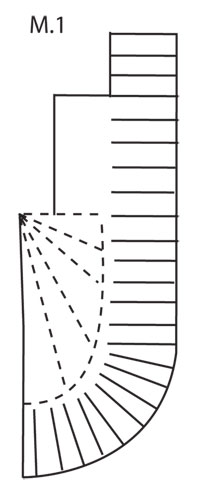 |
|||||||
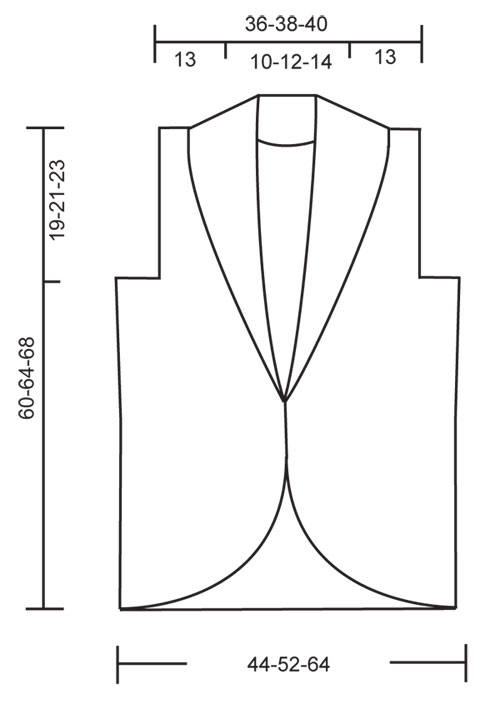 |
|||||||
Have you finished this pattern?Tag your pictures with #dropspattern #bamboobreezevest or submit them to the #dropsfan gallery. Do you need help with this pattern?You'll find 19 tutorial videos, a Comments/Questions area and more by visiting the pattern on garnstudio.com. © 1982-2026 DROPS Design A/S. We reserve all rights. This document, including all its sub-sections, has copyrights. Read more about what you can do with our patterns at the bottom of each pattern on our site. |
|||||||










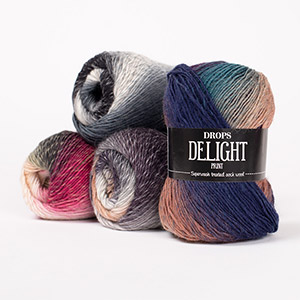

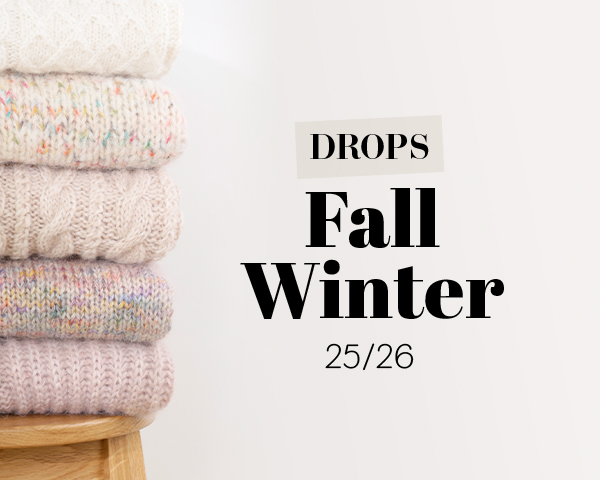


































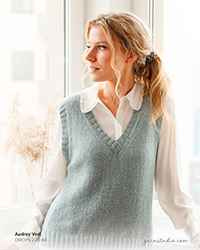

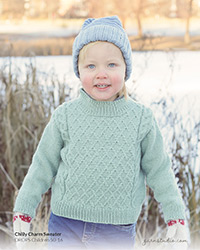
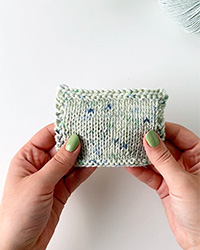

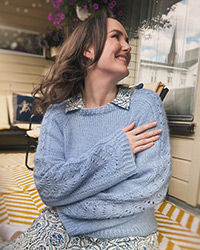
Post a comment to pattern DROPS 121-17
We would love to hear what you have to say about this pattern!
If you want to leave a question, please make sure you select the correct category in the form below, to speed up the answering process. Required fields are marked *.